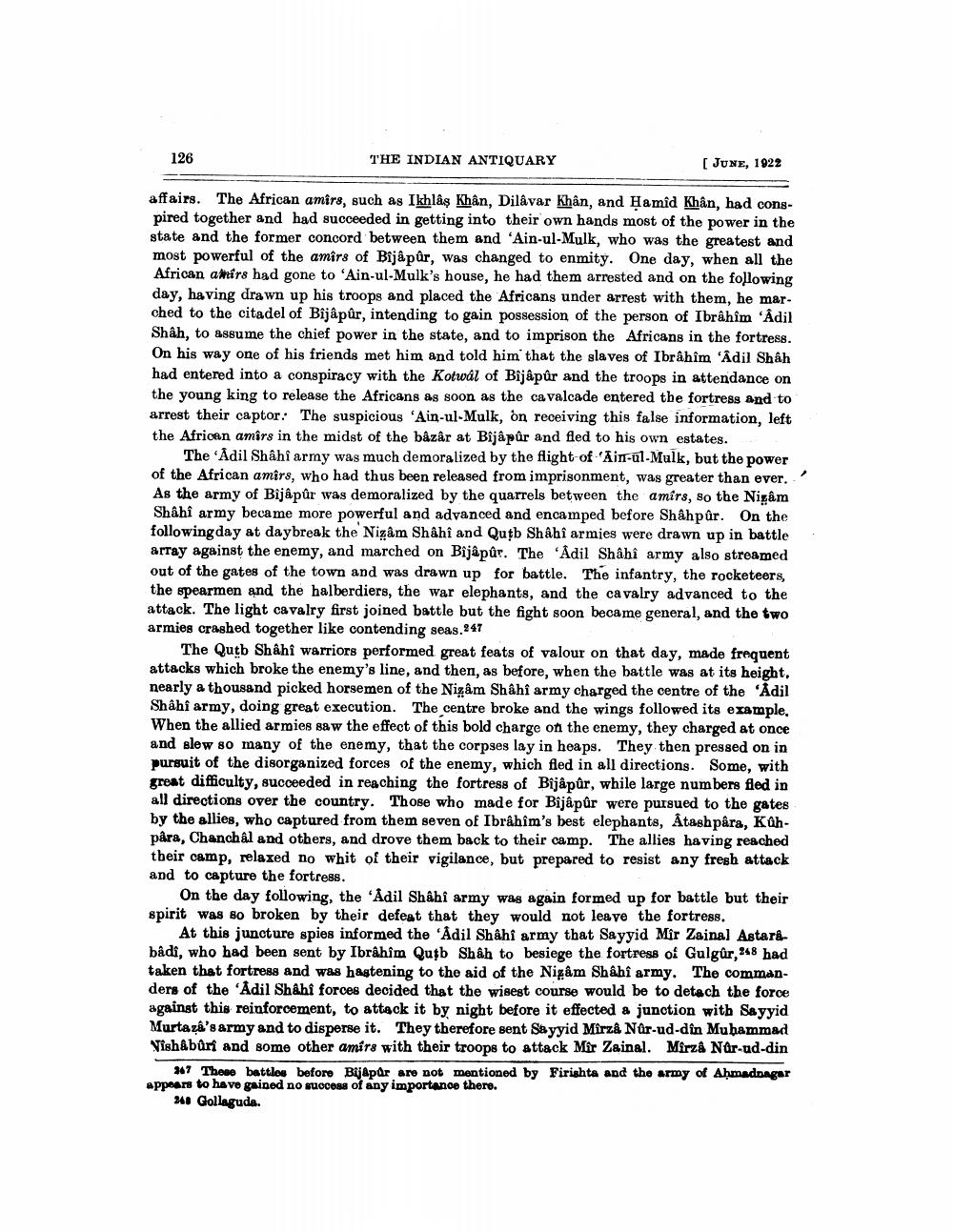________________
126
THE INDIAN ANTIQUARY
[ JUNE, 1922
affairs. The African amirs, such as Ikhlâs Khân, Dilâvar Khân, and Hamid Khân, had conspired together and had succeeded in getting into their own hands most of the power in the state and the former concord between them and 'Ain-ul-Mulk, who was the greatest and most powerful of the amirs of Bijâ pûr, was changed to enmity. One day, when all the African amirs had gone to 'Ain-ul-Mulk's house, he had them arrested and on the following day, having drawn up his troops and placed the Africans under arrest with them, he marched to the citadel of Bijapûr, intending to gain possession of the person of Ibrâhîm 'Adil Shâh, to assume the chief power in the state, and to imprison the Africans in the fortress. On his way one of his friends met him and told him that the slaves of Ibrahim 'Adil Shah had entered into a conspiracy with the Kotwal of Bijapûr and the troops in attendance on the young king to release the Africans as soon as the cavalcade entered the fortress and to arrest their captor: The suspicious 'Ain-ul-Mulk, on receiving this false information, left the African amirs in the midst of the bâzâr at Bijapur and fled to his own estates.
The 'Adil Shâhî army was much demoralized by the flight of-'Ain-ul-Mulk, but the power of the African amirs, who had thus been released from imprisonment, was greater than ever. As the army of Bijapur was demoralized by the quarrels between the amirs, so the Nigâm Shâhî army became more powerful and advanced and encamped before Shahpûr. On the following day at daybreak the Nizâm Shâhî and Qutb Shâhî armies were drawn up in battle array against the enemy, and marched on Bijâpûr. The 'Adil Shâhî army also streamed out of the gates of the town and was drawn up for battle. The infantry, the rocketeers, the spearmen and the halberdiers, the war elephants, and the cavalry advanced to the attack. The light cavalry first joined battle but the fight soon became general, and the two armies crashed together like contending seas.247
The Qutb Shahi warriors performed great feats of valour on that day, made frequent attacks which broke the enemy's line, and then, as before, when the battle was at its height, nearly a thousand picked horsemen of the Nizâm Shâhî army charged the centre of the 'Adil Shâhî army, doing great execution. The centre broke and the wings followed its example, When the allied armies saw the effect of this bold charge on the enemy, they charged at once and blew so many of the enemy, that the corpses lay in heaps. They then pressed on in pursuit of the disorganized forces of the enemy, which fled in all directions. Some, with great difficulty, succeeded in reaching the fortress of Bijapur, while large numbers fled in all directions over the country. Those who made for Bijapur were pursued to the gates by the allies, who captured from them seven of Ibrahim's best elephants, Atashpâra, Kühpara, Chanchal and others, and drove them back to their camp. The allies having reached tbeir camp, relaxed no whit of their vigilance, but prepared to resist any fresh attack and to capture the fortress.
On the day following, the 'Adil Shâhi army was again formed up for battle but their spirit was so broken by their defeat that they would not leave the fortress.
At this juncture spies informed the 'Adil Shâhî army that Sayyid Mir Zainal Astaribådi, who had been sent by Ibrahim Qutb Shah to besiege the fortress of Gulgur, 248 had taken that fortress and was hagtening to the aid of the Nigam Shâhi army. The commanders of the 'Adil ShAhi foroes decided that the wisest course would be to detach the force against this reinforcement, to attack it by night before it effected a junction with Sayyid Murtaza's army and to disperse it. They therefore sent Sayyid Mirza Nor-ud-din Muhammad Nishâbûri and some other amirs with their troops to attack Mir Zainal. Mirza Nor-ud-din
#47 These battles before Bij&par are not mentioned by Firishta and the army of Aḥmadnagar appears to have gained no success of any importance there.
241 Gollaguda.




